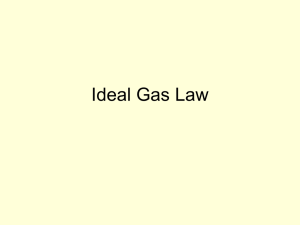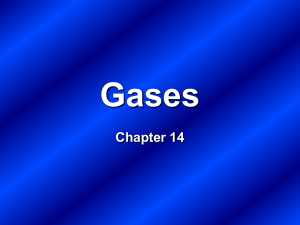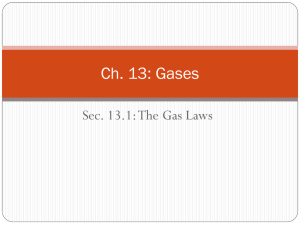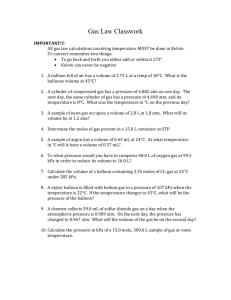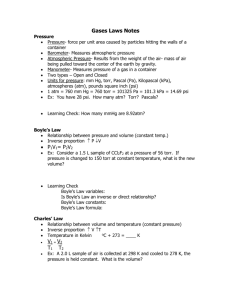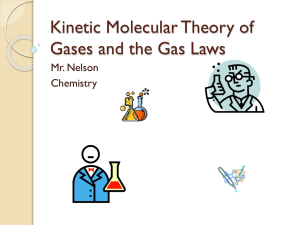Gases
advertisement
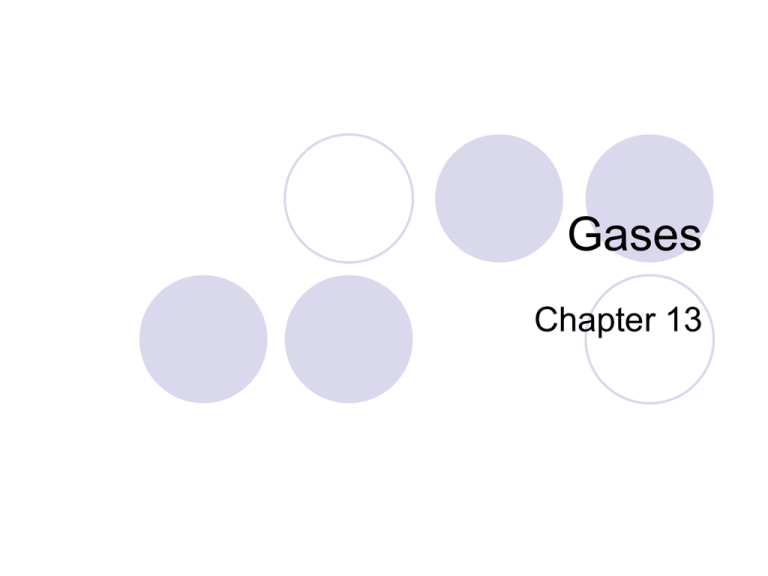
Gases Chapter 13 13.1 – The Gas Laws Kinetic Theory = assumes that gas particles: do not repel or attract each other are much smaller than the distances between them (particles have no volume) are in constant, random motion (straight lines) have completely elastic collisions (no loss of KE) Have the same average KE at a given temp. Nature of gases = determined by pressure, temperature, volume, and number of particles 13.1 – The Gas Laws Our variables = Pressure (P) Temperature (T) – Must be in Kelvin! Volume (V) Amount of particles/number of moles (n) Gas constant - R 13.1 – The Gas Laws Boyle’s Law = Studied relationship between pressure and volume of a gas At a given temp., volume and pressure are inversely related P1V1 = P2V2 P1 and V1 are initial conditions P2 and V2 are new conditions 13.1 – The Gas Laws (Boyle’s Law) 13.1 – The Gas Laws Steps for solving gas law problems = 1. Identify all variables. 2. Analyze the problem. “Which equation should I use?” 3. Rearrange the equation to solve for the unknown variable. 4. Plug in the numbers from step 1 into the equation from step 3 solve! 13.1 – The Gas Laws (Boyle’s Law) A sample of helium gas in a balloon is compressed from 4.0 L to 2.5 L at a constant temperature. If the pressure of the gas in the 4.0-L volume is 210 kPa, what will the pressure be at 2.5 L? 13.1 – The Gas Laws (Boyle’s Law) 1. Identify all variables. T=constant V1=4.0 L V2=2.5 L P1=210 kPa P2=? 2. Which equation should I use? We know P and V. Boyle’s Law: P1V1=P2V2 3. Rearrange the equation. To solve for P2, divide both sides by V2: P1V1 P2 V2 4. Plug in numbers from #1 into equation from #3: (210kPa)(4.0 L) ? kPa (2.5L) 13.1 – The Gas Laws (Boyle’s Law) The volume of a gas at 99.0 kPa is 300.0 mL. If the pressure is increased to 188 kPa, what will be the new volume? Air trapped in a cylinder fitted with a piston occupies 147.5 mL at 1.08 atm pressure. What is the new volume of air when the pressure is increased to 1.43 atm by applying force to the piston? 13.1 – The Gas Laws (Charles’s Law) Charles’s Law = Studied relationship between volume and temperature of a gas At a given pressure, volume and temperature are directly related . V1 V2 T1 T2 V1 and T1= initial cond. V2 and T2= new cond. 13.1 – The Gas Laws (Charles’s Law) 13.1 – The Gas Laws (Charles’s Law) A gas sample at 40.0°C occupies a volume of 2.32 L. If the temperature is raised to 75.0°C, what will the volume be, assuming the pressure remains constant? A gas at 89°C occupies a volume of 0.67 L. At what Celsius temperature will the volume increase to 1.12 L? 13.1 – The Gas Laws (Gay-Lussac’s Law) Gay-Lussac’s Law = Studied the relationship between temperature and pressure of a gas At a given volume, temperature and pressure are directly related .P P2 T1 T2 1 P1 and T1 = initial cond. P2 and T2 = new cond. 13.1 – The Gas Laws (Gay-Lussac’s Law) 13.1 – The Gas Laws (Gay-Lussac’s Law) The pressure of a gas in a tank is 3.20 atm at 22.0°C. If the temperature rises to 60.0°C, what will be the gas pressure in the tank? A gas in a sealed container has a pressure of 125 kPa at a temperature of 30.0°C. If the pressure in the container is increased to 201 kPa, what is the new temperature? 13.2 – The Combined Gas Law Combines all four equations together into one that relates temperature, pressure, and volume: P1V1 P2V2 T1 T2 13.2 – The Combined Gas Law A gas at 110 kPa and 30.0°C fills a flexible container with an initial volume of 2.00 L. If the temperature is raised to 80.0°C and the pressure increased to 440 kPa, what is the new volume? At 0.00°C and 1.00 atm pressure, a sample of gas occupies 30.0 mL. If the temperature is increased to 30.0°C and the entire gas sample is transferred to a 20.0-mL container, what will be the gas pressure inside the container? 13.2 – Avogadro’s Principle Avogadro’s principle = equal volumes of gases at the same temperature and pressure contain equal numbers of particles STP=Standard Temperature and Pressure, 0°C (273 K) and 1 atm **One mole of any gas will occupy 22.4 L at STP Now we can convert from liters to moles! 1 mole 0.25 L O 2 ? moles O 2 22.4 L 13.2 – Avogadro’s Principle Calculate the volume that 0.881 mol of a gas at standard temperature and pressure (STP) will occupy. How many moles of nitrogen gas will be contained in a 2.00-L flask at STP? 13.2 – The Ideal Gas Law All other gas laws apply to “a fixed mass” or “a given amount” Changing the number of gas particles affects other variables Increasing the number of particles will… Increase P (if T and V are constant) Increase V (if T and P are constant) We need a new equation that includes amount of gas present 13.2 – The Ideal Gas Law PV = nRT P = pressure V = volume n = number of moles of gas present R = ideal gas constant (depends on units of P) T = temperature UNITS of P UNITS of R VALUE of R atm L·atm mol·K 0.0821 kPa L·kPa mol·K 8.314 mm Hg L·mm Hg mol·K 62.4 13.2 – The Ideal Gas Law Calculate the number of moles of gas contained in a 3.0-L vessel at 3.00 x 102 K with a pressure of 1.50 atm. Determine the kelvin temperature required for 0.0470 mol of gas to fill a balloon to 1.20 L under 0.988 atm pressure. 13.2 – The Ideal Gas Law So what’s an ideal gas anyway? Its particles don’t take up space and have no intermolecular attractive forces Follows the gas laws under all conditions of T and P **In the real world, NO gas is truly ideal! When do real gases not behave as “ideal” gases? At high P and low T we can compress them into liquids Ex. Propane and liquid nitrogen 13.3 – Gas Stoichiometry Volume – Volume Solve same as mole-mole problems How many liters of propane gas (C3H8) will undergo complete combustion with 34.0L of oxygen gas? C3H8 + O2 → H2O + CO2 13.3 – Gas Stoichiometry Volume – Mass If 5.00L of nitrogen reacts completely with hydrogen at a pressure of 3.00atm and a temperature of 298K, how much ammonia, in grams, is produced? N2 + 3H2 → 2NH3 Calculate as a Volume to Volume Problem 5.00L N2 x (2NH3/1N2) = 10.00L NH3 Utilize PV=nRT to solve for the number of moles (n) (3.00atm)(10.00L) = n (0.0821L∙amt/mol∙K)(298K) Convert moles to mass 1.23mol NH3 ÷ 17.04g/mol NH3 = 21.0g NH3 n=1.23mol NH3 13.3 Gas Stoichiometry When 3.00L of propane gas is completely combusted to form water vapor and carbon dioxide at 350°C and 0.990atm, what mass of water vapor results? C3H8 + O2 → H2O + CO2




